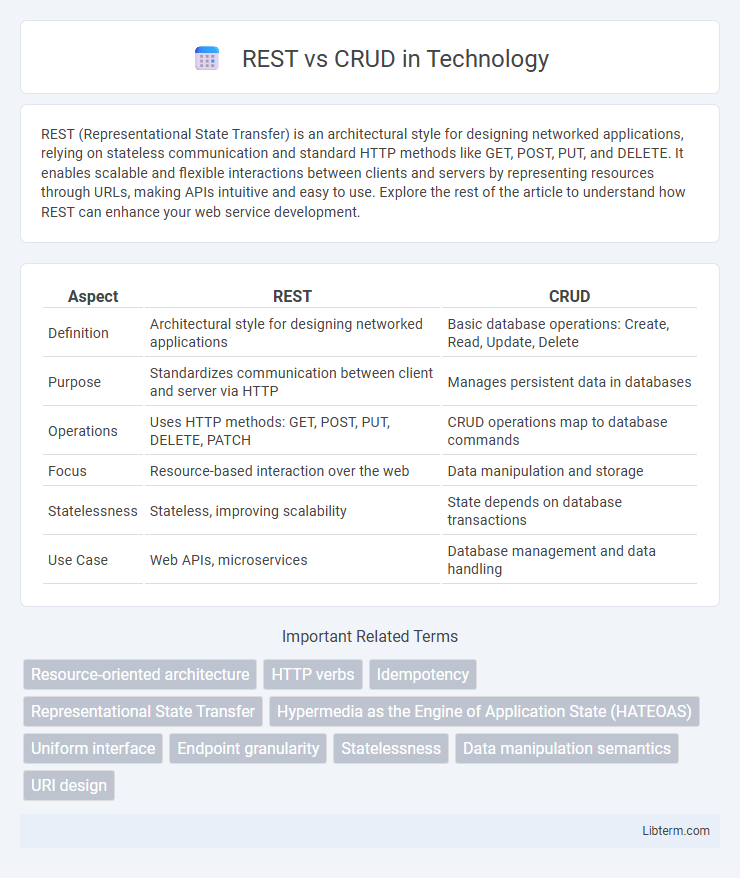REST (Representational State Transfer) is an architectural style for designing networked applications, relying on stateless communication and standard HTTP methods like GET, POST, PUT, and DELETE. It enables scalable and flexible interactions between clients and servers by representing resources through URLs, making APIs intuitive and easy to use. Explore the rest of the article to understand how REST can enhance your web service development.
Table of Comparison
| Aspect | REST | CRUD |
|---|---|---|
| Definition | Architectural style for designing networked applications | Basic database operations: Create, Read, Update, Delete |
| Purpose | Standardizes communication between client and server via HTTP | Manages persistent data in databases |
| Operations | Uses HTTP methods: GET, POST, PUT, DELETE, PATCH | CRUD operations map to database commands |
| Focus | Resource-based interaction over the web | Data manipulation and storage |
| Statelessness | Stateless, improving scalability | State depends on database transactions |
| Use Case | Web APIs, microservices | Database management and data handling |
Introduction to REST and CRUD
REST (Representational State Transfer) is an architectural style for designing networked applications, emphasizing stateless communication and scalable interactions through standard HTTP methods like GET, POST, PUT, and DELETE. CRUD (Create, Read, Update, Delete) represents the four fundamental operations used to manage persistent data in databases and applications. RESTful APIs commonly implement CRUD operations by mapping these actions to corresponding HTTP methods, enabling efficient data manipulation and resource management.
Defining REST: Principles and Components
REST (Representational State Transfer) is an architectural style that defines a set of principles for designing networked applications, emphasizing stateless communication, uniform interfaces, and resource-based interactions. Its components include resources identified by URIs, standard HTTP methods (GET, POST, PUT, DELETE) corresponding to CRUD operations, and representations such as JSON or XML for transferring resource state. REST principles enforce scalability, simplicity, and separation of client-server concerns, enabling efficient web service design beyond basic CRUD functionality.
Understanding CRUD Operations
CRUD operations represent the foundational actions of Create, Read, Update, and Delete, essential for managing persistent data in software applications. RESTful APIs use HTTP methods such as POST, GET, PUT/PATCH, and DELETE to map directly to CRUD operations, enabling standardized communication between client and server. Understanding CRUD in the context of REST is critical for designing efficient APIs that support resource manipulation while adhering to stateless principles and uniform interfaces.
How REST Relates to CRUD
REST (Representational State Transfer) architecture directly maps to CRUD (Create, Read, Update, Delete) operations through its use of HTTP methods: POST for Create, GET for Read, PUT/PATCH for Update, and DELETE for Delete. Each RESTful API endpoint represents resources where these CRUD actions manipulate the resource state in a stateless manner, promoting scalability and simplicity. Understanding this relationship aids in designing APIs that are intuitive and aligned with standard web protocols.
Key Differences Between REST and CRUD
REST (Representational State Transfer) is an architectural style for designing networked applications, emphasizing stateless communication and resource-based URLs, while CRUD (Create, Read, Update, Delete) represents the basic operations for persistent storage manipulation. REST maps HTTP methods--POST, GET, PUT/PATCH, DELETE--to CRUD operations but extends beyond basic database actions by defining stateless interactions, resource representation, and hypermedia controls. Key differences include REST's focus on resource state transfer and statelessness versus CRUD's simple data operation framework without enforcing architectural constraints or protocols.
Advantages of Using REST
REST architecture leverages stateless communication and standardized HTTP methods, enabling scalable and maintainable web services. Its resource-based design facilitates flexible interactions, promoting efficient client-server decoupling and faster development cycles compared to CRUD operations that primarily focus on database actions. The use of REST enhances interoperability and supports a wide range of data formats, improving performance and integration across diverse platforms.
Benefits and Limitations of CRUD
CRUD operations--Create, Read, Update, Delete--offer simplicity and clear mapping to database actions, making it straightforward for developers to implement basic functionalities. However, CRUD's limitations include lack of flexibility and scalability, as it doesn't inherently support complex transactions, state management, or fine-grained access control provided by RESTful APIs. Reliance on CRUD can lead to tightly coupled systems and difficulty in evolving API designs for more sophisticated client-server interactions.
Use Cases: When to Choose REST or CRUD
REST is ideal for complex web services requiring stateless communication and standardized interfaces, especially in distributed systems or APIs exposing resources with multiple representations. CRUD is best suited for simple database operations focused solely on data management tasks such as Create, Read, Update, and Delete within applications lacking extensive business logic or scalability needs. Use REST when you need scalability, flexibility, and interoperability across different platforms; opt for CRUD in straightforward data-driven scenarios with minimal protocol overhead.
Common Misconceptions About REST and CRUD
REST is often misconceived as being synonymous with CRUD operations, but REST is an architectural style that emphasizes stateless communication and resource manipulation through standard HTTP methods, not just Create, Read, Update, and Delete actions. Many assume RESTful APIs must strictly follow CRUD semantics, whereas true REST involves hypermedia as the engine of application state (HATEOAS) and can support complex interactions beyond simple CRUD. Understanding that REST's constraints focus on scalability, statelessness, and uniform interfaces helps dispel myths that it is merely a CRUD implementation.
Conclusion: Selecting the Right Approach
Choosing between REST and CRUD depends on the specific requirements of your application; REST offers a standardized, scalable framework leveraging HTTP methods for resource manipulation, ideal for complex, distributed systems. CRUD provides a straightforward, database-centric approach suited for simple applications requiring direct data operations with minimal overhead. Evaluating factors such as system complexity, scalability needs, and development resources ensures selecting the right architecture for efficient, maintainable software.
REST Infographic

 libterm.com
libterm.com